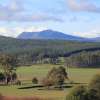
Primed for Growth: A situation analysis of the Tasmanian Forest and Wood Products Sector
Posted 04 September 2024
A report prepared by Greenwood Strategy Solutions Pty Ltd on behalf of the Tasmanian Forestry Hub finds Tasmania’s Forest and Wood products sector is primed for growth and better placed than any other Australian jurisdiction to transition to a new economy characterised by fibre, energy and carbon constraints.
It is defined by world class forest resources a responsive and innovative wood processing sector, work underway to respond to new and emerging technologies and markets and a supportive policy framework.
Australia’s forest and wood products sector is facing considerable change across multiple fronts and Tasmania is no different. There are both opportunities and challenges. Importantly, the industry in Tasmania is very well positioned to manage and benefit from the evolution of its operating environment, and the influence of local, national and global change drivers.
Tasmania has world class forest resources, a responsive and innovative wood processing sector and a supportive policy framework. It also has significant work already undertaken around industry transition to a new economy which will be characterised by fibre, energy and carbon constraints.
Tasmania’s forest and wood products sector is primed for growth and transformation, continuing its long legacy as a powerhouse of forest management and timber products innovation in Australia. To fully realise this potential and continue its significant contribution to Tasmania’s economy, the industry will need to work closely and collaboratively with policy and decision-makers at all levels of government and in complementary industries.
The situation analysis provides a starting point for that collaborative work. It presents an overview of the current state of play for the Tasmanian forest and wood products sector and details emerging opportunities and barriers. It considers a range of future potential scenarios and what they might mean for commercial and policy settings for the sector. It is intended as advice for the Australian Government, in line with the Tasmania Forestry Hub’s remit.
Read situation analysis HERE.
Share this Article
Latest Articles
-

17 September 2025
Celebrating excellence at the Tasmanian Timber Awards
-

17 September 2025
Forest Practices Authority Research Update Day
-

13 August 2025
Have you seen our Stems for CO2 Project signage on the Midlands Highway?
Archives
- ActivAcre hits milestone, calls for more farmers to get on board
- Napier's leading the way in sustainable forestry and carbon-neutral farming
- Sound science needed to assess carbon impacts of timber harvesting
- Newly appointed TFFPN Board of Directors
- Graduate Certificate of Forestry Scholarship
- Forestry Australia Mentoring Program 2025
- Forest Industry Roundtable planning for the long term
- Eagle Management Constraint Period extended
- Successful private native forest management celebrated
- $15 million investment in new ship loader to boost Bell Bay's forestry exports
- Standing with Tasmania's forestry industry: buy local
- TFPA: Tasmanian Freight Equalisation Scheme needs a ground-up review
- AFCA Gala Dinner celebrates industry excellence
- Fire permits now required Statewide
- Forest leaders hone skills in sustainable native regrowth management
- Tasmanian forests and the carbon market: Barriers and opportunities
- Spring is the time for fuel reduction burning
- Primed for Growth: A situation analysis of the Tasmanian Forest and Wood Products Sector
- Audit requirements cut for low-risk plantation projects
- Guidance and support for landowners after damaging winds
- Forestry Australia welcomes further definition of active forest management
- Farm & Forest Mapper Tool highlighted at Rural Youth Tasmania's Young Farmer of the Year competition
- Senate Select Committee inquiry into the Tasmanian Freight Equalisation Scheme
- Timberlink announces new wood composite products brand
- Newly developed protocol a vital tool for safeguarding forestry industry
- Red Hot Tips: Fire management for Tassie farmers
- Bioenergy: Fuelling industries with trees
- Harvesting trees: What you need to know
- Shelterbelts: How are they contributing to farm systems?
- Infill plantings and remnant vegetation: Why biodiversity depends on a thriving understory
- Plantation planning: The key to a successful plantation
- Exciting interactive forestry knowledge hub launched
- $450,000 farm forestry grant recipients revealed



